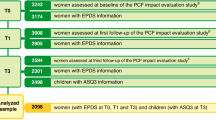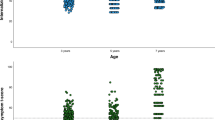Abstract
Increasing evidence indicates that, in addition to poverty, maternal depression, and other well-established factors, unpredictability of maternal and environmental signals early in life influences trajectories of brain development, determining risk for subsequent mental illness. However, whereas most risk factors for later vulnerability to mental illness are readily measured using existing, clinically available tools, there are no similar measures for assessing early-life unpredictability. Here we validate the Questionnaire of Unpredictability in Childhood (QUIC) and examine its associations with mental health in the context of other indicators of childhood adversity (e.g., traumatic life events, socioeconomic status, and parenting quality). The QUIC was initially validated through administration to a cohort of adult females (N = 116) and then further refined in two additional independent cohorts (male Veterans, N = 95, and male and female adolescents, N = 175). The QUIC demonstrated excellent internal (α = 0.89) and test–retest reliability (r = 92). Scores on the QUIC were positively correlated with other prospective indicators of exposures to unpredictable maternal inputs in infancy and childhood (unpredictable maternal mood and sensory signals), and accuracy of recall also was confirmed with prospective data. Importantly, the QUIC predicted symptoms of anxiety, depression, and anhedonia in the three study cohorts, and these effects persisted after adjusting for other previously established risk factors. The QUIC, a reliable and valid self-report assessment of exposure to unpredictability in the social, emotional, and physical domains during early life, is a brief, comprehensive, and promising instrument for predicting risk for mental illness.
Similar content being viewed by others
Log in or create a free account to read this content
Gain free access to this article, as well as selected content from this journal and more on nature.com
or
Notes
In this cohort only, one of the 22 items (“felt like I had a lot of energy”) was not administered owing to an oversight. The MASQ-AD score for this cohort was therefore the sum of 21 items.
References
Repetti RL, Taylor SE, Seeman TE. Risky families: family social environments and the mental and physical health of offspring. Psychol Bull. 2002;128:330–66.
Belsky J. Early human experience: a family perspective. Dev Psychol. 1981;17:3–23.
Reiss F. Socioeconomic inequalities and mental health problems in children and adolescents: a systematic review. Soc Sci Med. 2013;90:24–31.
Heim C, Nemeroff CB. The role of childhood trauma in the neurobiology of mood and anxiety disorders: preclinical and clinical studies. Biol Psychiatry. 2001;49:1023–39.
Casey BJ, Ruberry EJ, Libby V, Glatt CE, Hare T, Soliman F, et al. Transitional and translational studies of risk for anxiety. Depress Anxiety. 2011;28:18–28.
Baram TZ, Davis EP, Obenaus A, Sandman CA, Small SL, Solodkin A, et al. Fragmentation and unpredictability of early-life experience in mental disorders. Am J Psychiatry. 2012;169:907–15.
Walker CD, Bath KG, Joels M, Korosi A, Larauche M, Lucassen PJ, et al. Chronic early life stress induced by limited bedding and nesting (LBN) material in rodents: critical considerations of methodology, outcomes and translational potential. Stress. 2017;20:421–48.
Molet J, Maras PM, Kinney-Lang E, Harris NG, Rashid F, Ivy AS, et al. MRI uncovers disrupted hippocampal microstructure that underlies memory impairments after early-life adversity. Hippocampus. 2016;26:1618–32.
Ivy AS, Rex CS, Chen Y, Dube C, Maras PM, Grigoriadis DE, et al. Hippocampal dysfunction and cognitive impairments provoked by chronic early-life stress involve excessive activation of CRH receptors. J Neurosci. 2010;30:13005–15.
Molet J, Heins K, Zhuo X, Mei YT, Regev L, Baram TZ, et al. Fragmentation and high entropy of neonatal experience predict adolescent emotional outcome. Transl Psychiatry. 2016;6:e702.
Bolton JL, Molet J, Regev L, Chen Y, Rismanchi N, Haddad E, et al. Anhedonia following early-life adversity involves aberrant interaction of reward and anxiety circuits and is reversed by partial silencing of amygdala corticotropin-releasing hormone gene. Biol Psychiatry. 2018;83:137–47.
Bolton JL, Ruiz CM, Rismanchi N, Sanchez GA, Castillo E, Huang J, et al. Early-life adversity faciliates acquisition of cocaine self-administration and induces persistent anhedonia. Neurobiol Stress. 2018;8:57–67.
Brunson KL, Kramar E, Lin B, Chen Y, Colgin LL, Yanagihara TK, et al. Mechanisms of late-onset cognitive decline after early-life stress. J Neurosci. 2005;25:9328–38.
Avishai-Eliner S, Eghbal-Ahmadi M, Tabachnik E, Brunson KL, Baram TZ. Down-regulation of hypothalamic corticotropin-releasing hormone messenger ribonucleic acid (mRNA) precedes early-life experience-induced changes in hippocampal glucocorticoid receptor mRNA. Endocrinology. 2001;142:89–97.
Davis EP, Stout SA, Molet J, Vegetabile B, Glynn LM, Sandman CA, et al. Exposure to unpredictable maternal sensory signals influences cognitive development across species. Proc Natl Acad Sci USA. 2017;114:10390–5.
Belsky J, Schlomer GL, Ellis BJ. Beyond cumulative risk: distinguishing harshness and unpredictability as determinants of parenting and early life history strategy. Dev Psychol. 2012;48:662–73.
Ellis BJ, Figueredo AJ, Brumbach BH, Schlomer GL. Fundamental dimensions of environmental risk: the impact of harsh versus unpredictable environments on the evolution and development of life history strategies. Hum Nat. 2009;20:204–68.
Priel A, Djalovski A, Zagoory-Sharon O, Feldman R. Maternal depression impacts child psychopathology across the first decade of life: oxytocin and synchrony as markers of resilience. J Child Psychol Psychiatry. 2018. https://doi.org/10.1111/jcpp.12880.
Bernard K, Meade EB, Dozier M. Parental synchrony and nurturance as targets in an attachment based intervention: building upon Mary Ainsworth’s insights about mother-infant interaction. Attach Hum Dev. 2013;15:507–23.
Ainsworth MDS, Bowlby J. An ethological approach to personality development. Am Psychol. 1991;46:333–41.
Evans GW, Gonnella C, Marcynyszyn LA, Gentile L, Salpekar N. The role of chaos in poverty and children’s socioemotional adjustment. Psychol Sci. 2005;16:560–5.
Manczak EM, Williams D, Chen E. The role of family routines in the intergenerational transmission of depressive symptoms between parents and their adolescent children. J Abnorm Child Psychol. 2017;45:643–56.
Doom JR, Vanzomeren-Dohm AA, Simpson JA. Early unpredictability predicts increased adolescent externalizing behaviors and substance use: a life history perspective. Dev Psychopathol. 2016;28:1505–16.
Simpson JA, Griskevicius V, Kuo SI, Sung S, Collins WA. Evolution, stress, and sensitive periods: the influence of unpredictability in early versus late childhood on sex and risky behavior. Dev Psychol. 2012;48:674–86.
Glynn LM, Howland MA, Sandman CA, Davis EP, Phelan M, Baram TZ, et al. Prenatal maternal mood patterns predict child temperament and adolescent mental health. J Affect Disord. 2018;228:83–90.
Hooper LM, Stockton P, Krupnick JL, Green B. Development, use, and psychometric properties of the Trauma History Questionnaire. J Loss Trauma. 2011;16:258–83.
Cox JL, Holden JM, Sagovsky R. Detection of postnatal depression. Development of the 10-item Edinburgh Postnatal Depression Scale. Br J Psychiatry. 1987;150:782–6.
Baker DG, Nash WP, Litz BT, Geyer MA, Risbrough VB, Nievergelt CM, et al. Predictors of risk and resilience for posttraumatic stress disorder among ground combat Marines: methods of the Marine Resiliency Study. Prev Chronic Dis. 2012;9:E97.
Bernstein DP, Fink L, Handelsman L, Foote J, Lovejoy M, Wenzel K, et al. Initial reliability and validity of a new retrospective measure of child abuse and neglect. Am J Psychiatry. 1994;151:1132–6.
Watson D, Clark LA. The Mood and Anxiety Symptom Questionnaire. Iowa City, IA: Department of Psychology, University of Iowa; 1991.
Kendall AD, Zinbarg RE, Bobova L, Mineka S, Revelle W, Prenoveau JM, et al. Measuring positive emotion with the Mood and Anxiety Symptom Questionnaire: psychometric properties of the Anhedonic Depression Scale. Assessment . 2016;23:86–95.
Spielberger CD, Edwards CD, Montouri J, Lushene R. The State-Trait Anxiety Inventory for Children. Palo Alto, CA: Consulting Psychologist Press; 1973.
Kovacs M. Children’s Depression Inventory 2 (CDI 2). 2nd ed. North Tonawanda, NY: Multi-Health Systems Inc; 2011.
Shelton KK, Frick PJ, Wootton J. Assessment of parenting practices in families of elementary school-age children. J Clin Child Psychol. 1996;25:317–29.
Coddington RD. The significance of life events as etiologic factors in the diseases of children. A survey of professional workers. J Psychosom Res. 1972;16:7–18.
Matheny AP, Wachs TD, Ludwig JL, Phillips K. Bringing order out of chaos: psychometric characteristics of the Confusion, Hubbub, and Order Scale. J Appl Dev Psychol. 1995;16:429–44.
Rubin DB. Multiple imputation for nonresponse in surveys. New York, NY: John Wiley & Sons; 1987.
Azur MZ, Stuart EA, Frangakis C, Leaf PJ. Multiple imputation by chained equations: what is it and how does it work? Int J Methods Psychiatr Res. 2011;20:40–9.
Streiner DL. Starting at the beginning: an introduction to coefficient alpha and internal consistency. J Pers Assess. 2003;80:99–103.
Acknowledgements
We gratefully acknowledge the participants of these projects.
Author information
Authors and Affiliations
Corresponding author
Ethics declarations
Competing interests
The authors declare no competing interests.
Additional information
Publisher’s note: Springer Nature remains neutral with regard to jurisdictional claims in published maps and institutional affiliations.
Electronic supplementary material
Rights and permissions
About this article
Cite this article
Glynn, L.M., Stern, H.S., Howland, M.A. et al. Measuring novel antecedents of mental illness: the Questionnaire of Unpredictability in Childhood. Neuropsychopharmacol. 44, 876–882 (2019). https://doi.org/10.1038/s41386-018-0280-9
Received:
Revised:
Accepted:
Published:
Issue date:
DOI: https://doi.org/10.1038/s41386-018-0280-9
This article is cited by
-
Trauma-focused dialectical behavior therapy: study protocol for a randomized controlled multi-center trial in online and face-to-face formats
Borderline Personality Disorder and Emotion Dysregulation (2025)
-
Early life environmental unpredictability shapes non-suicidal self-injury: dual roles of experiential avoidance as mediator and moderator in Chinese college students
BMC Psychology (2025)
-
Associations of interpersonal and socioeconomic early life adversity dimensions with adolescents’ corticolimbic circuits, cognition, and mental health
Translational Psychiatry (2025)
-
Early Life Adversity and Empathy: A Scoping Review of Past Research and Recommendations for Future Directions
Clinical Child and Family Psychology Review (2025)
-
Exploring the Role of Empathy in the Association Between Early Life Adversity and Antisocial Behavior
Affective Science (2025)



